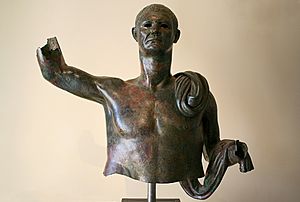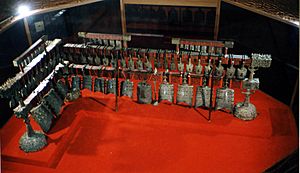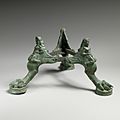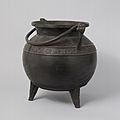Bronze facts for kids
Bronze is a metal alloy. This means it's a mix of two or more metals. Bronze is mostly copper, with some tin added. Usually, it has between 5% and 20% tin.
Contents
Bronze Through History
Bronze was the first alloy ever used by humans. People in Egypt started using it around 3500 years B.C. This important time is even named after it: the Bronze Age.
Bronze is much stronger than just copper or tin on their own. It also lasts longer than pure copper. Copper can get damaged by air and water, turning green and falling apart. This is called oxidation.
The Bronze Age ended when people learned how to make and work with iron. That's when the Iron Age began. Iron can be made even harder than bronze. However, iron can rust and wear away faster when pieces rub against each other. Iron is also very common and cheaper to make. Because of this, iron is now used for many things that bronze used to be used for.
Where is Bronze Used?
In Industry
Many different types of bronze are used in various industries. For example, Phosphor bronze is used for parts of ships, musical instruments, and electrical connections.
For Sculptures

Ancient artists loved using bronze for statues. The Assyrian king Sennacherib (who ruled from 704–681 BC) said he was the first to make huge bronze statues. Some of these weighed up to 30 tonnes!
In Ancient Greek art, bronze statues were seen as the best kind of sculpture. Not many have survived because bronze was a valuable material. Many famous Greek bronze statues are now known only through Roman copies made of marble.
In India, artists from the Chola dynasty used bronze to create amazing statues of Hindu gods. They used a special method called lost wax casting. This art form is still practiced today.
Other ancient cultures also made beautiful art from bronze. This includes the bronze heads from the Benin Empire in Africa. In east Asia, Chinese ritual bronzes from the Shang Dynasty and Zhou dynasty were often ceremonial containers, but some were figures. Bronze sculptures are known for lasting a long time, but even they can slowly break down due to tiny living things like yeasts.
Today, bronze is still a popular choice for large statues.
For Mirrors
Before we had glass that was perfectly flat, bronze was a common material for mirrors. The surface was usually slightly curved so you could see your whole face in a small mirror. People in many parts of the world discovered this use for bronze on their own.
Bronze mirrors have been found from the Middle Kingdom of Egypt (2040–1750 BCE). In Europe, the Etruscans made bronze mirrors in the sixth century BCE. The Greeks and Romans followed this trend. Even though other materials like speculum metal came along, bronze mirrors were still being made in Japan in the 1700s AD.
In Musical Instruments

Bronze is the best metal for bells. A special type of bronze called bell metal is used, which has about 23% tin.
Almost all professional cymbals are made from bronze. This gives them a good balance of strength and sound quality. Different types of bronze are used, like B20 bronze (about 20% tin) or B8 bronze (8% tin). The more tin in a bell or cymbal, the deeper its sound.
Bronze is also used for the windings on steel and nylon strings of many stringed instruments. This includes the double bass, piano, harpsichord, and guitar. Bronze strings are often used for lower notes on pianos because they make the sound last longer.
Bronze is widely used for many idiophones (instruments that make sound by vibrating their whole body) around the world. Examples include Tibetan singing bowls, temple bells, gongs, and cymbals from Asia. Ancient bronze drums from Thailand and Vietnam are 2,000 years old. Bronze bells from Thailand and Cambodia date back to 3,600 BCE.
Some companies even make saxophones from phosphor bronze today. Bell bronze is also used to make the tone rings of many professional banjos. This heavy bronze ring helps give the banjo a clear, powerful sound.
For Coins and Medals
Bronze has been used for coins. Most "copper" coins are actually bronze, with about 4% tin and 1% zinc.
Bronze has also been used for medals for centuries. Today, bronze medals are given for third place in sports and other events. This tradition comes from Greek mythology, which described three "Ages of Man": the Golden Age, the Silver age, and the Bronze Age (the time of heroes). This idea was first used at the 1904 Summer Olympics.
Types of Bronze
When an alloy is simply called "Bronze," it usually means it's a mix of copper and tin. If an alloy's name includes "Bronze" as part of two words (like "Aluminum Bronze"), it means the alloy is mostly copper. The other word tells you what other metal was mixed with the copper.
Other types of bronze include:
It's important not to confuse bronze with brass. Brass is a different alloy made from copper and zinc.
Images for kids
-
Houmuwu ding, the heaviest Chinese ritual bronze ever found. It's from 1300–1046 BCE and is in the National Museum of China.
-
A collection of bronze axes from the Bronze Age found in modern Germany. These were important tools and also used as a way to store wealth.
-
A bronze weight with an official order written on it, from the Qin dynasty.
-
A ritual tripod cauldron (ding) from around the 13th century BCE, in the Metropolitan Museum of Art.
-
An Etruscan tripod base for an incense burner, from 475-450 BCE, in the Metropolitan Museum of Art.
-
An Ancient Greek statue of Eros sleeping, from the 3rd–2nd century BCE, in the Metropolitan Museum of Art.
-
A pair of French Rococo firedogs (for a fireplace) from around 1750, in the Metropolitan Museum of Art.
-
A French Neoclassical mantel clock from 1757–1760, in the Metropolitan Museum of Art.
-
A pair of French Chinoiserie firedogs from 1760–1770, in the Metropolitan Museum of Art.
See also
 In Spanish: Bronce para niños
In Spanish: Bronce para niños




















